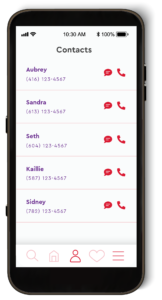Chapter 1: Why domain names matter to businesses

Since the ’90s, domain names have been featured in TV commercials, painted on the side of trucks and printed on business cards. While you can find them everywhere, you likely haven’t given domains a lot of thought – until you need to choose one.
Registering a domain name is quick, easy, and a relatively small expense when compared to all the startup costs of a new business. However, registering a good domain name is a bit more work. A catchy and memorable domain name is a critical part of your brand. It lets potential customers know what your business is all about, and that your website is safe, credible and trusted.
Choosing a name for your business
A business name and domain name are often related since they are variations of the same words. However, before you land on an official business name, register it with the government, order 1,000 business cards, or tattoo it on your arm, do a search of the following:
The general web
Search for your business name ideas on the web to check if an existing business is already using it or if there’s an alternative meaning you didn’t know about.
Registered business names and trademarks
Order a Nuans report to search existing Canadian corporate names, and conduct a search of registered trademarks in Canada on the Canadian Intellectual Property Office (CIPO) website.
Domain names
You can search what .CA domain names are available using a tool called WHOIS. If the one you want is taken, you may want to look at alternatives – we’ll get into that later. Many business names have been influenced based on the availability of a good domain name.
Social media handles
Which social media platforms are you going to use to promote your business? Find what handles are available.

You may think twice about naming your Canadian food delivery service Beaver Eats after seeing what it means on Urban Dictionary.
Make sure to do a web search of your desired business name to see if it has another meaning.
Claiming digital properties for your business
Claiming your business name across digital platforms
(including registering a domain name) helps with brand:
Protection
Prevent others from claiming the domain name you want and then reselling it for a high price; posing as your business and stealing your sales; or posting malicious content, intended to harm your brand’s reputation. There are rules and laws that can help businesses resolve these issues, but you can save yourself a future headache by securing digital properties from the get-go.
Recognition
Domain names and social media handles are often shorter variations of the full business name. There’s no requirement for the names across all digital platforms to be exactly the same. However, some consistency in names across digital platforms can help with brand recognition for your new business and make it easier for your customers to find you online.
Tip: Registering a domain name
should be one of the first steps in setting up your business.
Do it before anything is publicly announced and before you register your business name with the government, which in some cases makes the information publicly available.
If you aren’t 100% sure about the name your business, go ahead and register multiple domains for one year to cover your bases.
You can always opt not to renew them if you don’t end up using them.

So what exactly is a domain name?
The technical bit
A domain name is the address that helps users connect to the websites they are looking for. Instead of having to remember an Internet Protocol (IP) address (something like 11.11.11.111), a domain name translates that long string of numbers into something simple (like www.cira.ca).
Domain names are essentially a human-to-computer translation device so that you can type a unique string of letters, numbers, and hyphens into a web browser and bam, you are connected to a website.
Your phone’s contact list is a common example used to illustrate the function of domain names – it’s more practical to find your friend Aubrey in your contact list than to memorize the nine digits of his phone number.

Components of a domain name
Domain names are typically made up of two key parts:
- The second-level domain is the part of the domain that comes immediately before (or to the left) of the dot. It usually represents a business, organization or blog.
- The top-level domain (TLD) is the section after the dot. Some top-level domains are affiliated with countries and called country code top-level domains (ccTLDs), like .CA for Canada, .fr for France or .mx for Mexico.
Chapter 2: Choosing a domain name

Choosing a top-level domain
One way to attract Canadians to your business is to offer free samples of maple syrup. Problem is, that could get expensive (and messy) after a while. A much better approach is to choose a .CA domain for your website.
There is a Canadian presence requirement for individuals, organizations and businesses to register a .CA domain, so website visitors will automatically recognize that your website and business is Canadian.
83% of Canadian internet users prefer shopping on a site with a .CA.
– Strategic Counsel

.CA is the ideal choice for businesses that…
- Sell primarily to Canadians
- Offer professional services to a specific geographic region in Canada
- Operate in industries with geographic or national restrictions or regulations (such as healthcare, financial services, etc.)
- Feature Canada proudly as a central element of their brand

Bonus: by choosing .CA, you’re giving back to Canada’s internet community
A portion of the proceeds of .CA registrations helps fund innovative projects through our Community Investment Program. Since 2012, .CA has helped provide $7.95 million in grants to internet projects across Canada.
Ottawa-based non-profit Actua received a grant from CIRA in 2019 for their digital literacy project, AI for Education.
To the left of the dot – how to choose a domain name for your business
It’s easy to spot when a business has a poorly thought out domain name – i.e. if it’s incredibly long or confusing.
So what makes a good domain name? Here are a few examples to show how everyone does it a bit differently.
| Business name | Domain name | Variation |
|---|---|---|
| Peace by Chocolate | peacebychocolate.ca | Business name |
| Kichesippi Brewing Company | kbeer.ca | One letter from business name + product |
| Mountain Equipment Co-op | mec.ca | Abbreviation |
| Mrs. McGarrigal’s Fine Food and Mustard | mustard.ca | Product keyword |
| Switch Energy | maketheswitch.ca | Catchy call-to-action |
| Bread and Butter Bakery and Fine Pastries | breadandbutter.ca | Short version of business name |
| Number 9 Audio Group | number9.ca | Letter + number |
| Tails and Trails | tailsandtrailsnl.ca | Business name + serviced location |

How long should a domain name be?
Shorter is usually better; it’s easier to remember and reduces the room for error when it is typed into a web browser. It’s perfect for marketing and printed materials (like business cards, store signs or pamphlets) or merchandise (like t-shirts and hats).
About half of currently registered .CA domain names are between five and 12 characters long. Really short domains (less than five characters) are nifty, but like parking spaces at a Canadian Tire on December 24, many of the good ones are taken or are in high demand in the domain name aftermarket.
Search for a .CA domain name
What to do if the domain name you want is taken
First of all, as Canadians, we’re so sorry that you have to deal with this. However, we’re all about solutions here, so let’s see what your options are.
Option 1: Finding an alternative domain name
This is the easiest and fastest option. Our domain search tool offers some suggested variations based on what you previously searched. If you like any of those, go ahead and register them. Otherwise, review the table of examples from the previous section to see what creative alternatives you can come up with.
Option 2: Buying a domain name in the aftermarket. If you absolutely need a specific domain name that is already registered, here are some tips.
Heads up, this route may be expensive – we’re talking hundreds to thousands of dollars. If you’re pinching toonies, this might not be a good option.
Visit the domain name first to check if it is being used. If it’s being used by an established business, chances are it will be more difficult/expensive to obtain.
You can use a domain name broker to help you reach out to the person who currently has the domain registered, negotiate a selling price and help with the transfer.
Want to learn more?
Want to learn more? In this post we do a deeper dive into purchasing a domain in the aftermarket.
Do you need more than one domain name?
Domain names are relatively inexpensive, (it’s the hosting and other add-ons that add up), so registering additional ones and redirecting them to your main site can help you protect your brand and capture additional traffic. Here are some examples of businesses using a domain portfolio:
Your domain contains a word that’s commonly misspelled or spelled differently in American English:
neighborhoodcoffee.ca → neighbourhoodcoffee.ca
You want to use a short, catchy domain in print material or for a campaign:
rd.ca → readersdigest.ca
Chapter 3: Registering a domain name
Players in the website ecosystem
A quick overview of a few terms related to domain names and websites that are helpful to know.
Registrant
An individual that registers a domain name. That’s you!
Registry
The entity that maintains the integrity of a top-level domain. The Canadian Internet Registration Authority (CIRA) is the registry for .CA. Hey, that’s us!
Web hosting service
A company that provides space on a server to allow your website to be viewed on the internet.
Content Management System (CMS)
Software that helps you create, manage and modify website content. Popular platforms include WordPress, Wix and Weebly. Pick one that’s good fit for your technical skill level and price point.
Registrar
The company you purchase your domain from and manage its settings. Most companies offer other services in addition to selling domain names. Which brings us to…
How to choose a registrar
When you find your perfect .CA domain name, you will need to choose a certified .CA registrar to purchase it from. Here are some things to consider for evaluating which company will best meet your needs.
Prices and promotions.
Compare prices to determine how much your domain name will cost and what is included in your purchase. Find out if they bill monthly or annually, and in Canadian dollars. Cheapest isn’t always best – you are investing in an important part of your business.
Customer service.
If you’re new to this whole website thing, chances are you’ll have a few questions and run into a few issues along the way. See if your registrar offers 24/7 support, live chat, and other helpful services.
Additional services.
You may need email, hosting, and/or e-commerce to make use of your domain name. You can mix and match services with different companies or keep things simple and use a one-stop shop. See what registrars have deals with web builders, such as a free one-page website or a free trial.
Recommendations.
Contact your favourite tech-savvy friend and see which companies they think highly of. If you don’t have any friends, seek out customer reviews and testimonials online.
Top domain registration tips from CIRA’s support team
Our support team is really nice, but you can save yourself the trouble of having to call them by following these tips to avoid common domain name issues
Always register the domain name yourself.
Don’t let a third party (like your agency) register it for you. As the business owner, create your registrar account yourself and using your contact information. This gives you full control over managing the domain.
Choose a strong password.
It should go without saying, but choose a strong, unique password for your account with your registrar. You can also refer to our ultimate domain name security checklist for more tips like setting up two-factor authentication.
Provide accurate contact information.
When you register a domain, you have to provide information like a phone number and email address. Make sure you provide accurate information so your registrar can contact you for important domain name updates. And if your info changes, update it in your profile.
Don’t let your domain name expire.
You can register a .CA for one to ten years at a time. You’ll probably get renewal reminder emails from your registrar, but sometimes life gets busy. It’s a lot easier to renew your domain before it expires, so put the renewal date in your calendar.
Use a separate email address.
That is, don’t use [email protected] as the contact email for the domain moose.ca. Avoid a potential black hole of domain despair: if you unwittingly let your domain expire, your email will stop working so you won’t be able to use that email for validation to get your site back up and running.
Contact your registrar if you run into issues.
If you have questions, it’s usually best to contact your registrar first, because there’s only so much CIRA is able to help you with.
Chapter 4: What’s next? Using your domain name
Your domain name has been successfully registered. Congratulations are in order!
Here are a few next steps we’d recommend:
Get a custom email address
Create your own custom email address on your domain name, like [email protected] and [email protected]. This bumps up your credibility factor for your budding business.
Get an SSL certificate
An SSL certificate is important, and even critical if you’re using your site for ecommerce. It’s what protects the information (e.g. a credit card number) that customers enter into your website. It also gets you that nice trusty lock icon and the “s” in “https” next to your domain name.
Publish a "coming soon" page
Even if you’re not ready to build a full-blown website, you might consider propping up a “coming soon” page with some information to tease your audience. Note that if you build a website (even if it’s just a simple one-pager) it may take a few hours to resolve.
What now?
You’ve successfully registered a domain name for your business, but your work isn’t done yet. In fact, this is just the beginning! You’ll need to look into things like search engine optimization (aka SEO or getting people to visit your website), developing a content strategy, and keeping your website secure. Thing is, this guide is already long enough, so we’re going to leave you here.
Chapter 5: About CIRA

Hello from Ottawa! We’re the Canadian Internet Registration Authority — but you can call us CIRA. We’re the folks who manage the .CA domain name registry on behalf of all Canadians.
We’re a not-for-profit, member-based organization that that is helping build a better online Canada.





